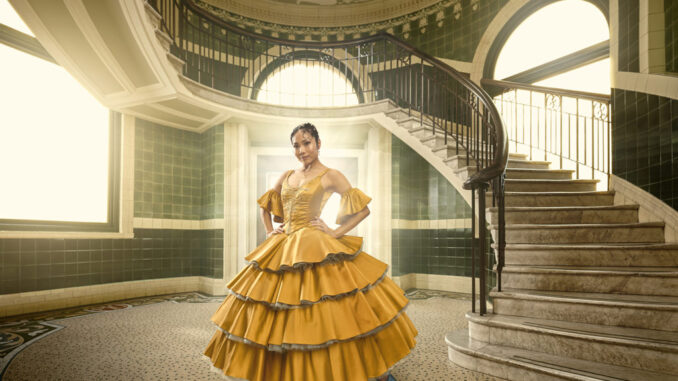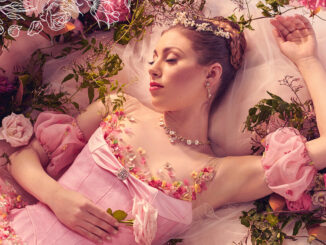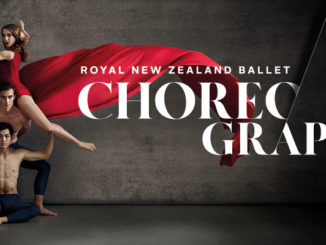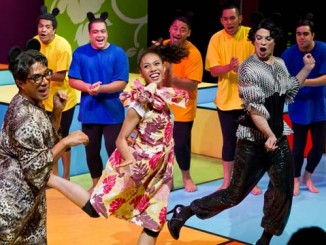
[A fairy-tale for our challenging times]
The Royal New Zealand Ballet’s ‘dream team’ of choreographer Loughlan Prior and composer Claire Cowan return with their largest and most ambitious project to date. Perfectly timed to coincide with the reopening of Wellington’s St James Theatre, it is clear that with a protagonist who rescues herself, two princes, an animated tapestry, and an unconventional coach ride to the ball this Cinderella will be no restaged relic.
Emboldened by the success of their 2019 production Hansel & Gretel, the creative team have struck a fine balance of joyful self-awareness of the classical narrative ballet form; celebrating the best elements and moving on from the problematic ones. The result is a queer, feminist ballet simultaneously timeless in setting and contemporary in feel. In reconsidering the Cinderella story, Prior ensures beloved elements are maintained (Cinderella’s transformation, the ball, the clock striking midnight, and the all-important glass slipper) while pop culture references and humour are woven throughout. Developed collaboratively with set, costume and visual effects partners Emma Kingsbury and POW Studios, Cinderella is cohesive, holistically crafted, and resoundingly spectacular. Prior’s attention to world-building pays dividends in all his works, however, the scale and creative freedom of Cinderella gives the entire team the scope to invest deeply, create freely and therefor shine.
From the animated façade of the St James to the depth and height of staging and concept, Cinderella feels akin to modern musical theatre, igniting the narrative in 3D and challenging the boundaries of the proscenium. Similarly, Cowan’s original score is rooted in the classical, but enriched and expanded by her cinematic style and eclectic musical influences. An exuberant Orchestra Wellington conducted by Hamish McKeich wield contrasting time periods, genre and instruments with vibrancy and panache. Incorporating medieval hurdy gurdy, taiko, drum kit, congas, 1980s synthesiser, Latin rhythms, recorded EDM alongside a traditional orchestra could easily become chaotic or fractious, however, Cowan’s considered leitmotifs, emotional narrative structure and care for “danceable” composition ensure the opposite result. Cinderella’s score moves the story along with necessary emotional integrity and delivers the dance party of the year.
Sparked by the feminist poetry of Amanda Lovelace and embracing the concept of contrast, Kingsbury’s sets and costumes give the designer an active presence in the ballet. Referencing modern branding, traditional tulle, period costume, pop culture playfulness, and character colour palettes, garments are brilliantly bold and impressively detailed. Costuming of the main characters is effective in terms of identity and development, and offers unexpected surprises for audience members watching closely. A trolley-load of delightful mannequins emphasises the value of coordinated ensemble costuming, which is also employed with the large cast of child extras. Unfortunately, some choreographic detail and clarity of movement of The Fab Five and Eligible Maidens is compromised due to the sheer visual busyness onstage, diminishing their impact and presence.
At the heart of Royal New Zealand Ballet’s Cinderella are the dancers, and Prior’s collection of characters developed with his lovely pithy humour. Dancing the title role on opening night, Mayu Tanigaito as Cinderella is magnificent. Her characterisation, emotional range, attention to detail, warmth, energy, and virtuosic classical technique give her the star-power to drive the ballet’s narrative arc, and ensure the audience is behind her every step of the way. Partnered by Laurynas Vėjalis as the sweet and sincere Royal Messenger this casting seamlessly matches two principal artists with inimitable elevation and sustained control. Adorable and quietly courageous, Prince Charming is danced with delightful sensitivity by Joshua Guillemot-Rodgerson. When he finds his soulmate in the Kingdom Next Door’s Prince Dashing, danced by Shae Berney, “the two princes share their stories, and the world starts to make sense.” This pairing gives rise to Cinderella’s most innovative choreography, and the romantic pas de deux between two men presented free from farce or parody feels like a milestone for the classical ballet canon.
As the Stepsisters, Sara Garbowski and Kirby Selchow are a thoroughly dynamic duo, brilliantly entertaining and flawlessly funny. Ana Gallardo Lobaina as the social climbing and manipulative Stepmother provides a suitably vile juxtaposition to Cinderella’s decency, while Kate Kadow as the Fairy Godmother delivers fouettés and fun resplendent in her plastic tutu. The Fab Five – a great addition to the plot and an absolute hit the audience – are versatile and engaging, particularly Shaun James Kelly as Thiery who is perfectly cast. Principal Paul Mathews as Cinderella’s grieving and vulnerable Father is detailed and sustained, and it is a treat indeed to enjoy the skill and stage presence of Ballet Master Clytie Campbell as she returns to the stage in the character role of the Queen.
Underneath the vibrant production values and astute dark comedy, Cinderella is a celebration of individuality, authenticity, the story of finding your voice, and the courage to seek your own “happy ever after”. A joyous occasion, the Royal New Zealand Ballet’s production is a fairy-tale for our challenging times, and as the spontaneous applause and cheers erupting from the very first scenes indicated, there is still magic aplenty to be found in the theatre.
Cinderella tours Wellington, Auckland, Napier, Christchurch and Dunedin 3 August – 3 September, 2022.
Choreography: Loughlan Prior
Music: Claire Cowan
Set & Costume Design: Emma Kingsbury
Lighting Design: Jeremy Fern
Visual Effects Partner: POW Studios
Orchestra Wellington conducted by: Hamish McKeich




Leave a Reply